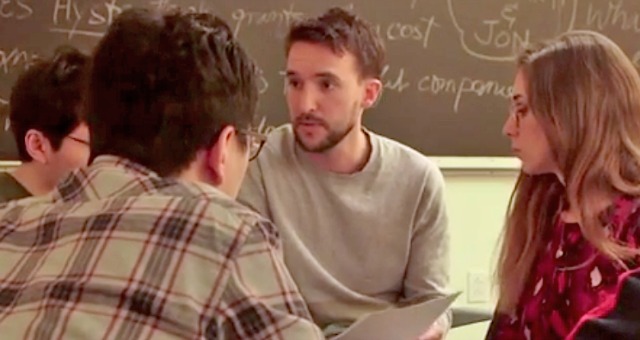It’s no secret that technology continues to transform the way educators teach and the way students learn. Increasingly, students want to be able to learn on their own terms--that is, they want to be able to study whenever, wherever, and however they choose, and they expect institutions and faculty to be accommodating. We’ve likely all had students who for one misguided reason or another believed that their professors--particularly those teaching online—were available around the clock to answer questions, provide feedback, and generally just be there if needed. As unrealistic as this belief is, wouldn’t it be nice if instructors could approximate being available 24/7? Well, you can—sort of—through the power of podcasting.
Read more ›CURRENT ARTICLE • November 02
OTHER RECENT ARTICLES
Discussion boards. Google documents. YouTube videos. TED Talks. Khan Academy. These are just a few of the many resources some of us have used in our ever-growing arsenal of techie tools. We want to stay on the cutting edge. The Sloan Consortium (now Online Learning Consortium) predicts this trend toward an increased usage of technology will continue into the foreseeable future. So we continue to hone our skills, taking advantage of an ever-increasing array of technological options. We attend conferences, exchange ideas with colleagues, read up on the latest innovations—all in the interest of keeping our teaching on the technology edge. But I sometimes worry that we may have gone over the edge.
Read More ›Showtime in the Classroom: Seven Ways Streaming Video Can Enhance Teaching
 Many faculty seek to make creative use of films in their teaching, whether in traditional class screenings or through flipped classrooms. However, there are many obstacles to teaching with videos: the costs and constraints of DVD as a technology; limited DVD collections at some libraries; time involved in creating videos for one’s own classes; the popularized, questionable nature of many videos found on YouTube; the lack of institutional subscriptions to mainstream streaming services; and copyright concerns. Fortunately, in recent years, most campus libraries have subscribed to copyright-licensed and academically oriented streaming video collections such as Kanopy, NBC Learn, Films on Demand, PBS Video Collection, and Swank’s Digital Campus. These “Netflix” of academia offer fantastic functionalities and curated content designed with pedagogy in mind.
Many faculty seek to make creative use of films in their teaching, whether in traditional class screenings or through flipped classrooms. However, there are many obstacles to teaching with videos: the costs and constraints of DVD as a technology; limited DVD collections at some libraries; time involved in creating videos for one’s own classes; the popularized, questionable nature of many videos found on YouTube; the lack of institutional subscriptions to mainstream streaming services; and copyright concerns. Fortunately, in recent years, most campus libraries have subscribed to copyright-licensed and academically oriented streaming video collections such as Kanopy, NBC Learn, Films on Demand, PBS Video Collection, and Swank’s Digital Campus. These “Netflix” of academia offer fantastic functionalities and curated content designed with pedagogy in mind.
 In general education humanities courses, at least two problems seem universal:
In general education humanities courses, at least two problems seem universal:
 Professor Philip LaRocco is reimagining his Energy Business and Economic Development course with digitized lecture materials, collaborative assignments, and real-time feedback. With funding from Columbia University’s Office of the Provost, LaRocco teamed up with the Columbia Center for New Media Teaching and Learning (CCNMTL) to build a learning environment more conducive to the world in which his students currently intern, and plan to work in post-graduation. He is following a “flipped classroom” model—filming some of his lectures and making them available to students prior to class meetings—making way for more elaborate group review, discussions, and other collaborative assignments during class.
Professor Philip LaRocco is reimagining his Energy Business and Economic Development course with digitized lecture materials, collaborative assignments, and real-time feedback. With funding from Columbia University’s Office of the Provost, LaRocco teamed up with the Columbia Center for New Media Teaching and Learning (CCNMTL) to build a learning environment more conducive to the world in which his students currently intern, and plan to work in post-graduation. He is following a “flipped classroom” model—filming some of his lectures and making them available to students prior to class meetings—making way for more elaborate group review, discussions, and other collaborative assignments during class.
For the first time since leaving graduate school almost 15 years ago, I enrolled in a class, “Maps and the Geospatial Revolution,” and the first day wasn’t like that of any other class I’ve taken. In lieu of finding a seat, I placed a virtual pin (labeled “participant”) on a digital world map, along with 47,000 of my classmates scattered around the world. I was enrolled in a MOOC.
Read More › “Am I writing to myself?” That’s what I used to wonder when I first started teaching Spanish online a year ago. My learning management system, message boards, and group emails were impersonal and unresponsive—more like writing in my diary than sharing information with my students. I never knew for certain who read and understood my announcements or received an (electronic) handout or assignment directions. In the traditional, on-campus classroom, I’m a very interactive, hands-on kind of instructor, so I also went from knowing each and every one of my students by name and even a little bit about them to having nothing more than a roster with 115 names and majors. I just wasn't satisfied, so I did something that others in the field had encouraged me not to do; I created a Facebook group for the class, and I’m not going back.
“Am I writing to myself?” That’s what I used to wonder when I first started teaching Spanish online a year ago. My learning management system, message boards, and group emails were impersonal and unresponsive—more like writing in my diary than sharing information with my students. I never knew for certain who read and understood my announcements or received an (electronic) handout or assignment directions. In the traditional, on-campus classroom, I’m a very interactive, hands-on kind of instructor, so I also went from knowing each and every one of my students by name and even a little bit about them to having nothing more than a roster with 115 names and majors. I just wasn't satisfied, so I did something that others in the field had encouraged me not to do; I created a Facebook group for the class, and I’m not going back.
 New technology continues to emerge and influence the classroom learning environment. Students now have immediate and unlimited access to digital content, resources, and databases. To capitalize on the wealth of available Internet resources, many educators are joining the Bring Your Own Device (BYOD) initiative, which encourages students to use their own personal electronic devices (smartphones, tablets) during class time to augment and support learning. For example, students search for definitions and websites that enhance the course topic being discussed. Or students (as a class or in small groups) use online resources to solve a posted scenario.
New technology continues to emerge and influence the classroom learning environment. Students now have immediate and unlimited access to digital content, resources, and databases. To capitalize on the wealth of available Internet resources, many educators are joining the Bring Your Own Device (BYOD) initiative, which encourages students to use their own personal electronic devices (smartphones, tablets) during class time to augment and support learning. For example, students search for definitions and websites that enhance the course topic being discussed. Or students (as a class or in small groups) use online resources to solve a posted scenario.
 As a faculty member, I am always challenged with finding pedagogical techniques that allow my students to connect with course content, each other, and myself in new and interesting ways. Student presentations can help achieve this goal, but they require a wealth of time for each student to present and get immediate feedback from peers and the instructor. Some classes are so large that in-class presentations may not be feasible at all. Or, if you are a faculty member who is not on a block schedule, you would have to use several of your 50-minute class sessions to allow each student a chance to present his or her work. What’s more, some students have a difficult time listening to dozens of peer presentations in one sittings and may tune out after the first few presentations.
As a faculty member, I am always challenged with finding pedagogical techniques that allow my students to connect with course content, each other, and myself in new and interesting ways. Student presentations can help achieve this goal, but they require a wealth of time for each student to present and get immediate feedback from peers and the instructor. Some classes are so large that in-class presentations may not be feasible at all. Or, if you are a faculty member who is not on a block schedule, you would have to use several of your 50-minute class sessions to allow each student a chance to present his or her work. What’s more, some students have a difficult time listening to dozens of peer presentations in one sittings and may tune out after the first few presentations.
Are your students constantly updating their statuses on Facebook? Uploading selfies to Instagram at inappropriate times? Refreshing their Twitter feed every five seconds? Chances are the answer is “yes,” and if you’re like the majority of teachers, you find it mildly annoying at best, or a serious impediment to learning at worst.
Read More ›




